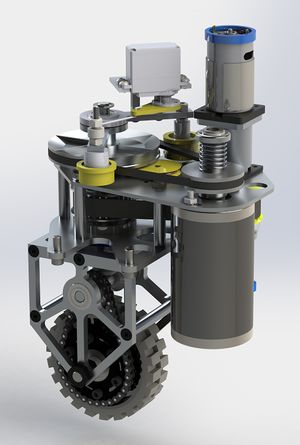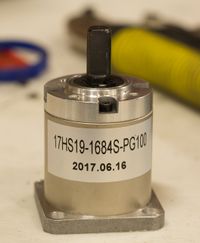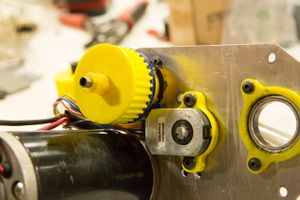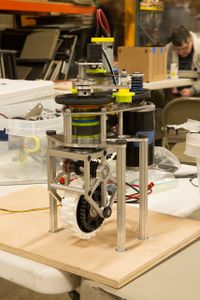Difference between revisions of "DEWBOT XIV Drive Train"
MaiKangWei (talk | contribs) (→Proliferation of Printed Parts) |
MaiKangWei (talk | contribs) |
||
| Line 29: | Line 29: | ||
A CIM motor provides the drive power for the wheels. | A CIM motor provides the drive power for the wheels. | ||
| − | + | An AndyMark 9015 motor (am-0912) served as steering motor. This motor is mounted on a 17HS19-1684S-PG100 100:1 reduction gearbox from Steppermotorsonline.com. Mounts for the steering motor are 3-D printed. | |
The belt tensioning servo is a Rev Robotics Smart Robot Servo (REV 41-1097). Its metal gears provide good durability. | The belt tensioning servo is a Rev Robotics Smart Robot Servo (REV 41-1097). Its metal gears provide good durability. | ||
| − | |||
| − | |||
| − | |||
| − | |||
---- | ---- | ||
[[Category:Robot]][[Category:DEWBOT XIV]][[Category:Drive-train]][[Category:Swerve Drive]][[Category:Photo Galleries]][[Category:Engineering]] | [[Category:Robot]][[Category:DEWBOT XIV]][[Category:Drive-train]][[Category:Swerve Drive]][[Category:Photo Galleries]][[Category:Engineering]] | ||
Revision as of 13:25, 21 March 2018
Sab-BOT-age's swerve focus for 2018 was to enable straight and accurate driving, in both autonomous and teleoperated modes. Accurate driving and navigation in autonomous was quickly identified as a critical performance requirement for FIRST Power-Up.CVT swerve, first employed in DEWBOT XIII, was again used for the 2018 robot.
Backlash Reduction
Backlash in 1640's swerve were traced back to: 1) the reduction gearbox; and 2) undersized keys on pulleys.We have used 3-stage 132:1 BaneBot P60 gearboxes for steering since 2012 (DEWBOT VIII). These gearboxes are not re-used year-to-year, but are purchased new for each generation of swerve drives. The key cause of backlash in the P60 gearboxes is the double-D connection between the final planet carrier and the output shaft. This backlash tends to increase over time.
The team identified a 100:1 planetary gearbox (17HS19-1684S-PG100) from Steppermotorsonline.com with integral output shaft/planet carrier. This gearbox has extremely low backlash and testing in 2017 indicated that they were robust enough for FRC service. These gearboxes are purchased with stepper motors attached; these stepper motors are removed and replaced with AndyMark 9015 motors (mated via printed mounts). In spite of having to purchase and discard the stepper motors, this gearbox is a cost savings vis-à-vis the P60 it replaces.
The weak point of the new gearbox is its unfortunate D output shaft. A great deal of development went into making the connection to this D-shaft reliable and durable. This effort is likely to be ongoing.
An alternative gearbox for consideration is VexPro's Versaplanetary gearbox. These also have low backlash (with spline connections between output shaft and planet carriers and between stages). The form factor of the Versaplanetary offers challenges and it would add weight and cost to 1640's swerve modules.
To reduce backlash at the pulley/shaft connections:
- ) The drive pulley is now printed with a 1/2" Hex hub. A 1/2" Hex shaft mates precisely with this pulley.
- ) On the driven side, a 1/4" key fits precisely in a keyway in the 1" pivot shaft. A printed pulley with a 1/4" broached keyway fits snugly over this.
Quadrature Encoder
After years of employing makeshift encoder devices (none of which were satisfactory) on our swerve modules, we finally took the action of adding a real quadrature encoder. This was driven by the need to navigate and maneuver accurately during autonomous (also to make teleoperated drive easier).The encoder is on its own axle, driven by round belt by a pulley piggy-backed under main driven pulley.
Proliferation of Printed Parts
Motors
A CIM motor provides the drive power for the wheels.
An AndyMark 9015 motor (am-0912) served as steering motor. This motor is mounted on a 17HS19-1684S-PG100 100:1 reduction gearbox from Steppermotorsonline.com. Mounts for the steering motor are 3-D printed.
The belt tensioning servo is a Rev Robotics Smart Robot Servo (REV 41-1097). Its metal gears provide good durability.



